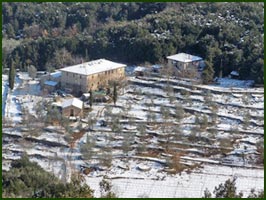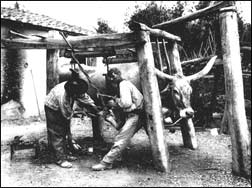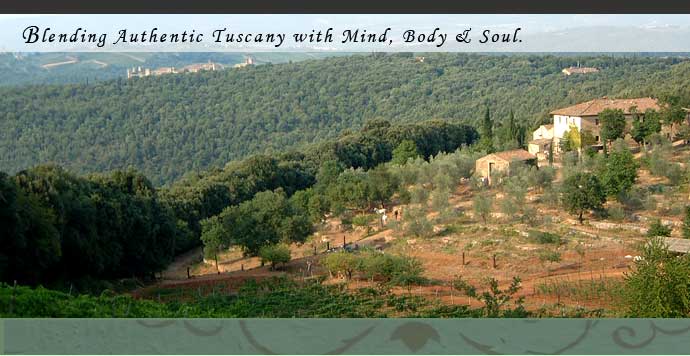About The Property
In Ebbio, a 14th century Tuscan Farmhouse,
welcomes you with its spacious rooms full of fascinating
history. Trying not to forget the old country ways of living
you can still discover this feeling. Silence, earthy colors
and  fragrances
are still prominent. Guests warmly welcomed, the food is vegetarian
and mostly organic. Horseback riding, hiking, biking, donkey
trekking or simply soak in an old wine barrel transformed
into a unique floating pool are all wonderful ways to experience
this Tuscan landscape already sacred to the Etruscans.
fragrances
are still prominent. Guests warmly welcomed, the food is vegetarian
and mostly organic. Horseback riding, hiking, biking, donkey
trekking or simply soak in an old wine barrel transformed
into a unique floating pool are all wonderful ways to experience
this Tuscan landscape already sacred to the Etruscans.
The Tuscan scenery developed as a result
of many years of local, traditional labor which has slowly
chiseled away at this fertile yet hostile agricultural land.
The
farmhouse, like Ebbio, was the nucleus of domestic and working
life. It had to be self-sufficient, using only half of the annual
crop, as the other half was given to the land lord/owner as rent
payment. The house was built close to the woods because of the
proximity to sources of wood fuel, fruit, and plants.
History Steeped in Tradition
The Fireplace and the Oven
A grand fireplace was central to the
kitchen of the traditional Tuscan country house. Here the
family met  together
to prepare enormous meals in the evening, requiring a great
deal of labor. The fireplace was large and from it hung all
the instruments of the kitchen, like ladels and strainers,
and free spaces for benches and chairs were available under
the chimney in order to chat and relax. The oven was found
either inside of the house like it is in Ebbio, or outside
where it was used for making bread and was easier to fill
up with wood.
together
to prepare enormous meals in the evening, requiring a great
deal of labor. The fireplace was large and from it hung all
the instruments of the kitchen, like ladels and strainers,
and free spaces for benches and chairs were available under
the chimney in order to chat and relax. The oven was found
either inside of the house like it is in Ebbio, or outside
where it was used for making bread and was easier to fill
up with wood.
The Cart
The wooden cart was the most common form of transportation. The
wood used to make the cart was taken from trees on the property.
The hub, the wheel's middle circle, was built according to
what type of wood was available at the time.
The Yoke
The wooden yoke was needed to attach the oxen to the plows. The
most common type was the double yoke, which was placed on the
backs of the two animals and then tied with a rope around their
necks. The central part had a hole for steering the plow.
The yoke was attached firmly if the animals were the same size,
and flexible when they had different dimensions.
The Travaglio
 The travaglio was a wooden structure used
for shoeing oxen. It was made from four strong wooden poles
fixed into the ground, limiting the movements of the animals.
Once fixed the animal was lifted and shoed to strengthen his
hooves for the continuously heavy work in the fields.
The travaglio was a wooden structure used
for shoeing oxen. It was made from four strong wooden poles
fixed into the ground, limiting the movements of the animals.
Once fixed the animal was lifted and shoed to strengthen his
hooves for the continuously heavy work in the fields.
The Plow
The wooden plow was used to make ruts in the
land before sowing the seeds. It was made up of a blade which
cut into the ground. Oxen pulled the plow, harnessed by a long central
piece of wood.
Chestnut Trees
Chestnut trees have always grown in the
woods near the house. At one time chestnuts were a fundamental
part of the traditional diet. After they were dried it was
an excellent pastime during long winter nights to shell and
prepare the nuts by the fireplace. Wood from the trees was
used to make poles and benches, always very useful for the
farm.
The Animals
There were many animals on the farm, such as: dogs, chickens,
geese, sheep, oxen, cows, horses, and  donkeys.
The donkeys were often used for carrying goods from one farm
to another. They were very important because they could walk
in rocky places where horses and oxen had difficulty.
donkeys.
The donkeys were often used for carrying goods from one farm
to another. They were very important because they could walk
in rocky places where horses and oxen had difficulty.
Charcoal
The preparation of charcoal was a distinguishing
skill of the local Tuscan farmer that required a specific method.
The charcoal was made out of a semispherical wooden pile placed
in a circular clearing located near the trails in the forest.
After a long, slow burning and cooling process, charcoal was
ready to be transported home, with the help of donkeys, for
domestic uses.
The carbonery was built between the end of the winter and the
end of the spring. It was very important to avoid bad weather
and windy days. To ensure good conditions, a cross was placed
on the top of the pile.
Sculpting the Tuscany Landscape
Dry stone walls were an integral part of the Tuscan environment.
Because the olive trees were to be planted on the naturally
undulating land, dry stone walls were constructed to prevent
soil erosion. The mezzaluna were built all along the slopes
to accommodate the many trees, and were constructed exclusively
out of stone.
The Courtyard
The "AIA" is an open space between the farmhouse and the hay
barn. This courtyard was built and paved in a special way to
prevent flooding. It was elevated above the level of the land
and positioned in a sunny, airy spot to facilitate the drying
of products. In the olden days the courtyard was used for
grinding grains and as a space for dancing and celebrating.
The Hay barn and the Wicker
Objects
After the harvest, the wheat stalks and other remains were used
as food for the many animals on the farm. The straw was piled
up into a large conical pile with a pitchfork and firmly pressed
down to prevent rainwater from seeping through. Wicker collected
from the woods was used to make bread baskets and other containers
used to collect and dry various fruits and vegetables.
The Cantina
The infamous Tuscany wines were at the time prepared to satisfy
a family's needs, but also to sell. It was one of the farm's
principle commodities. The young vines needed a lot of attention,
and selling the final product was only the last step in the
long process. Some of the objects still in use today are
the tinello, the bigoncio (barrels for collecting grapes),
and the demigons with or without a straw cover and some funnels.
The Kitchen and Well
Close to the main house there was often a stone well where
water for food preparation was collected. In the kitchen
there were separate wooden racks for drying dishes and hanging
the clay and copper pots and pans. The rack for drying dishes
was located above the sink so excess water would not drain
onto the floor.
The Bedwarmer
Big country houses didn't have heating, so they were built
to receive the most of the solar energy and the natural
rise of warm air; downstairs, the oven and the animals
in the stable provided some heat. The bedrooms were usually
upstairs facing south. Bedwarmers, small pans that contained
embers and were placed under the covers, were also used
to warm up the beds for the cold winter nights.


